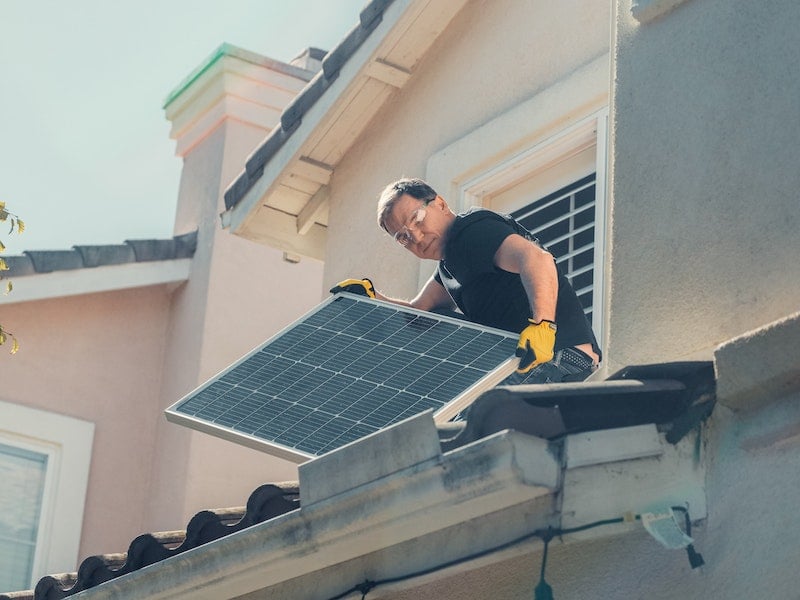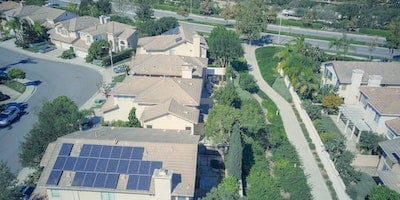
How Do Solar Panels Work?
Learn how solar panels work and how they work with your solar system.
Is solar right for you?
Find out in less than a minute.
Solar energy has been around for decades, and solar energy technology will continually grow into better and most efficient machines - all for the sake of providing us with clean, renewable energy.
Many homes and businesses get solar panels and a solar energy system to provide more energy for their properties while also saving money in the process. As temperatures continually soar in the summer and drop extremely low in the winter, having alternative fuel sources to power our homes and businesses is key to help with the fight against climate change.
In this article, we’re going to breaking down how solar panels absorb energy and how that energy is made into usable electricity. We’ll be also be breaking down the different types of solar panels, how inverters work, and the benefits of having an energy storage system.
How Do Solar Panels Absorb Solar Energy?
In short - when photons (sunlight) hits your solar panels, electrons are removed from their atoms. The conductors within your solar panels guide the electrons through a circuit, which then generates direct current (DC) energy.
With multiple panels holding multiple cells, they form a solar array which gives you a bulk amount of energy. The DC energy is then guided into your inverter unit, which then converts DC energy into usable alternating current (AC) energy.
When you have more panels, more photons can be absorbed, and more energy can be sent into your home.
The main type of solar panels is called monocrystalline solar panels, which are the most common type of solar panels that are being used today.
Monocrystalline solar panels we produced from a single crystal of silicon, and are more effective at absorbing sunlight than polycrystalline solar panels. There are myriads of different brands, sizes, and qualities of monocrystalline solar panels, so make sure you ask us for some guidance before you purchase solar panels.
Types of Solar Panels and Their Benefits
Monocrystalline Solar Panels:
Monocrystalline solar panels have cells that are made of silicon wafers. These wafers are assembled into rows and form a rectangle, which is then covered with a glass sheet.
Generally, solar panels that are lined with black cells are monocrystalline solar panels. Since it’s a singular cell sheet, the cells appear black because of how light interacts with the pure silicon crystal.
Certain companies, such as Sun Power, have lined the backs of their monocrystalline solar panels with a copper support board, which helps with the durability of cells, as well as the retention rate of the solar energy that enters the cell.
Monocrystalline solar panels generate a considerable amount of energy while having high efficiencies and power capacity. Monocrystalline solar panels usually have efficiencies of 20% or higher. Monocrystalline solar panels are generally larger in size as well, with many monocrystalline solar panels within the 300 watts to now exceeding 400-watt panels.
If you’re looking for the best technology alongside the type of panel which produces the most power, monocrystalline solar panels are the way to go for you. They are also the most expensive option in comparison to polycrystalline and thin-filmed solar panels. The manufacturing process required for monocrystalline solar cells is considered arduous. The production plant or factory needs to create the whole panel from a singular silicon crystal, which is also expensive to make.
Polycrystalline solar panels
While not quite as efficient as their monocrystalline counterparts, Polycrystalline solar panels are cheaper and are still a good option depending on the goals of your solar system. Polycrystalline (or just “poly”) cells have an efficiency of about 23% compared to 28% efficiency of mono cells.
Poly solar panels on the other hand have an efficiency of 20% compared to 22% of mono solar panels. But, as mentioned before monocrystalline have a slightly better performance in low irradiance.
Half-Cut Cell Solar Panels
As their name suggests, half-cut cell solar panels have solar cells that are cut in half. The reasoning behind this type of solar panel technology is the fact that these cells improve the module’s overall performance and durability.
Because these solar cells are halved, their outputs are also halved, meaning that they have less resistive losses which allow for the cells to generate more power. Imagine your roof tiles for example. Rather than have one giant roof shingle for each section of your roof, you use many smaller titles in order to reduce the overall mechanical stress of the roof. This leads to a longer-lasting roof while decreasing the breakage level for each tile.
The half-cut solar cells operate with the same fundamental mechanics, which allows them to last longer than traditional solar panels. Half-cell modules also allow for more energy to be produced in low-light or partially shaded environments. Over time, this leads to a higher level in power production and more efficiency than their full-cell counterparts.
Bifacial Solar Panels:
Bifacial solar panels are able to absorb solar power from both sides of the panel. Bifacial solar panels are generally installed on a highly reflective surface, and some bifacial module manufacturers suggest that there is a 30% increase in power production from the backside reflection of light alone.
Many bifacial solar panels use monocrystalline cells, but there are polycrystalline designs as well.
Some are considering bifacial solar panels to be the future of the solar industry. You can double the amount of energy production without removing the absorbing power of the mono/polycrystalline solar cells. There is a higher energy yield, with better low-light performance as well.
If you’re looking for the future of solar power panels, bifacial panels might be the next big thing.
Shinged Cell Solar Panels:
Shingled cell solar panels are the latest and greatest in terms of new efficient solar module technology. Shingled solar panels have cells that are cut into 5 or 6 strips. They are then overlaid, much like how roof shingles are. These overlays form electrical connections and are joined together using an electrically conductive adhesive to allow for better conductivity and flexibility.
These types of solar panels don’t need to have busbars, and they have no gaps in between cells. Additionally, they generate more power per square meter. Due to the fact that the cells are exposed to more sunlight, they can produce more energy than conventional solar panels.
The downside is that these shingled cell solar panels are the most expensive out of all the types of solar panels, so make sure to take that into consideration.
How Do Inverters Work?
A solar inverter is a machine that takes in Direct Current or DC energy and transforms it into an Alternating Current or AC energy.
Your home’s appliances can only use AC energy, which is why you need an inverter to essentially convert the DC energy from your solar panels into usable AC energy. There’s not much to how an inverter works - other than basically being a converter unit of DC to AC energy.
What is An Energy Storage System?
An energy storage system is essentially a gigantic battery for your solar energy. Solar panels convert sunlight into DC energy which is then converted to AC energy by your inverter. Any energy you use during the day will be created from your solar energy system, and normally - any energy you don’t use from your solar energy system will then be sent into your utility grid. From there, your utility energy providers will send you a credit on your energy bill, for all the energy you created for them.
Instead of sending that unused energy to your utility grid, an energy storage system absorbs it. You can then utilize this energy for your home during the night, which is a step forward for your home to become truly off-grid.
There are also some additional benefits of having an energy storage system, such as:
Reliability during blackouts or natural disasters: By having an energy storage system, you protect your home and business from utility grid malfunctions that leave you without any on-grid power. An energy storage system serves as backup power for your home or business and will allow you to continue to work and live in peace even when those around you don’t have energy.
Energy independence: Texas boasts one of the highest costs for electricity and the highest rate increase (an increase of 4.1% per year). With an energy storage system, you can finally become independent from your utility energy provider - which will protect you from rising energy costs.
By becoming energy independent, you will no longer have to pay your utility energy providers, which will save money for your home or business. In doing so, you are also reducing your carbon footprint to nearly zero.
Appreciation in your home/business’s value: Having a solar energy system increases the value of your home, and by having an energy storage system attached to it, you will have increased your home’s value even further.
If you eventually were to sell your home, having a solar energy system alongside an energy storage system can be an additional selling point, especially if you’re looking to sell your home or property in Texas.
As a business, by showing you are a carbon-zero company, you will have the added prestige of being a green business. This will raise your reputation as a company, while also serving as an additional selling point to your customers.
Written by Thad Warren
Thad is a native Texan who has worked in the energy industry for just over 5 years.
Connect
Recent Posts
Compare Texas Solar Buyback Plans
Discover the best Texas solar energy buy back programs for 2025! Compare rates, terms, and providers to maximize savings and make the most of your solar investment.
September 2025

7 minutes

How Efficient Are Solar Panels
How efficient are solar panels compared to other types of energy generation?
March 2023

4 minutes

What You Need To Know About The California Solar Mandate
Learn how the California Solar Mandate changes how new homes are built.
July 2023

4 minutes


